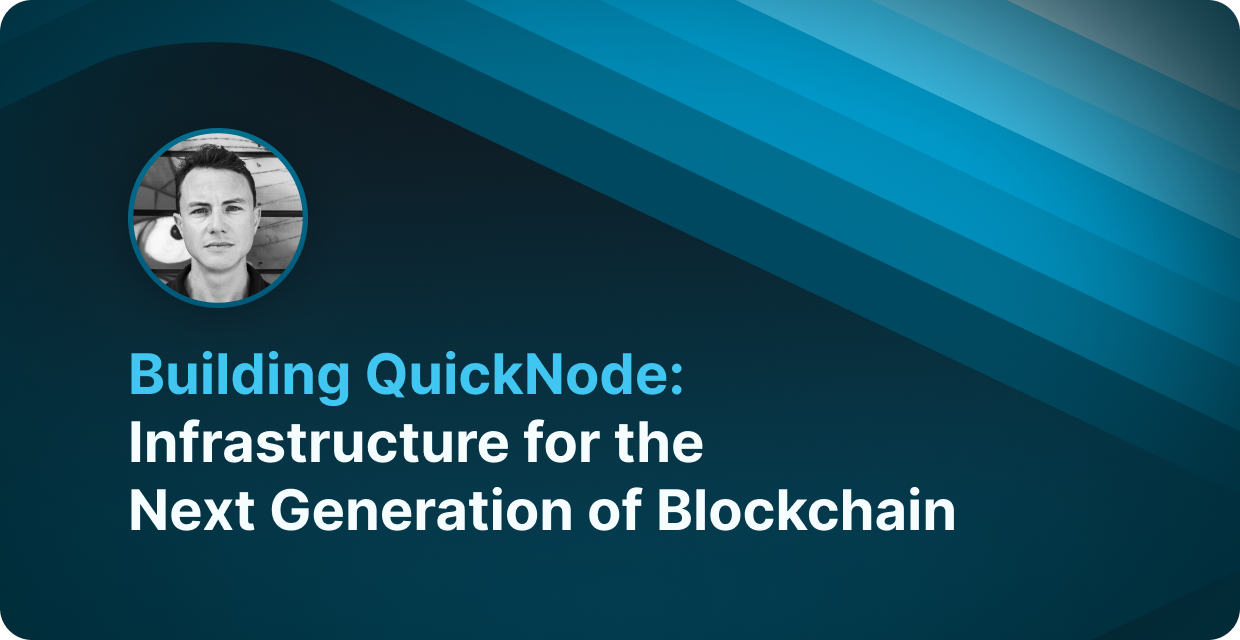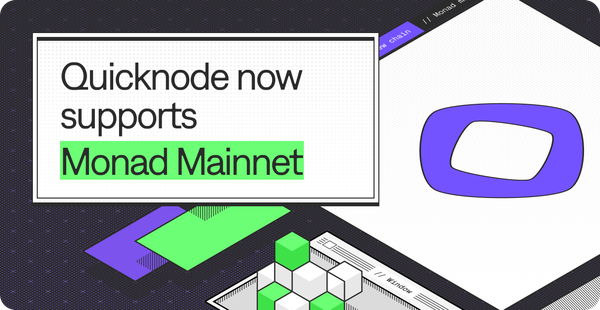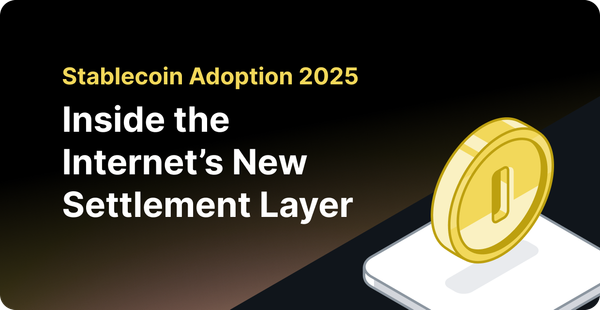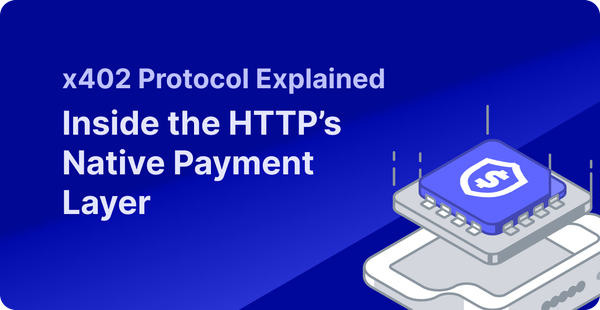QuickNode: Building the Infrastructure for the Next Generation of Blockchain
Join QuickNode co-founder Dmitry Shklovsky as he discusses blockchain infrastructure, building decentralized applications, and the future of Web3 development on TheCube's Crypto Trailblazer Series.

QuickNode co-founder and co-CEO Dmitry Shklovsky recently appeared on The Cube's Crypto Trailblazer series, part of the Cube plus NYC Wired event. In this insightful conversation with host John Furry, Dmitry discussed QuickNode's mission, the evolution of blockchain infrastructure, and how they're empowering developers to build the future of Web3.
John Furry: Hello everyone. Welcome back to the Crypto Trailblazer series. I'm John Furry, host of The Cube. We're in The Cube Studios in Palo Alto, California, part of The Cube plus NYC Wired event, featuring all the trailblazers in crypto blockchain, really setting the infrastructure for the next generation.
Dmitry is here, co-founder and co-CEO of QuickNode. Dmitry, thanks for coming on. Appreciate you.
Dmitry: Thank you. My pleasure. Pleasure to be here.
John Furry: We've been really seeing a lot of activity. The maturation of crypto, it's obviously had its cycles. Now we have a different environment, certainly here in the US, but it hasn't changed the game around the world. You guys are doing some cool stuff. Do a quick intro to QuickNode, what you guys do, set the table, and then we'll dig into what you guys do, why you were founded, and what you're building.
Dmitry: Thank you, John. QuickNode is a leading on-chain developer platform. We provide developers and businesses with the tools to build, scale, and manage quality blockchain applications. So, from things like high-performance nodes, elastic APIs, and most everything in between, we simplify the complexities of working with blockchain technology.
Whether you're launching a decentralized app, exploring layer two solutions, or looking to bring the benefits of blockchain to your enterprise, QuickNode delivers reliable, scalable infrastructure backed by 4Nines SLA and a team of 100-plus around the world to make sure that you succeed.
John Furry: We've seen the movie many times. I've seen a few waves around the track, so to speak. Not to mix metaphors, but like every wave, there's always this enablement. Obviously blockchain is key, but software apps, dapps, decentralized applications will be big, right?
So the question everyone says is okay, how do they work? What's the state of the art if I want to build a decentralized application? How do I think about that? Because if I'm a developer, maybe I'm old school or I have a database, I got serverless, I'm in the cloud now. I want to go to full, efficient, transparent on-chain. I want immutability; I want all the benefits of decentralized infrastructure. What do I need to think about? What are the core principles, concepts that I have to lock into as a developer?
Dmitry: Right. You want your application to be as good, if not better than the current web, let's call it Web2. It needs to be fast, reliable, and easy to use, and this is what we help businesses realize.
When you bring your application on-chain, you can leverage this permissionless, transparent, interoperable ledger, let's call it, or database, where anything that you build can easily be used by anyone and can also be used with other instruments and applications. You don't need to ask permission or go to another company and say, "Hey, can we do business?" These are all open on the blockchain. It removes a lot of friction and barriers to building complex and elaborate applications.
John Furry: Talk about your business model. Are you targeting developers, providing a marketplace, is it a dev platform? Do I have to pick a chain like Ethereum or Bitcoin? What's your approach?
Dmitry: At the end of the day, the user of the platform is typically a developer, though we do have prosumers. Maybe you're looking for a reliable RPC API for your wallet, maybe you're running an arbitrage script or bot and you need something that can fetch data within milliseconds and then execute a trade using that data.
Or, if you're a larger company like Coinbase, Uniswap, or Binance, you want to ensure your millions of customers can read and write things on-chain. Finding token balances, NFTs in your wallet, any interaction on-chain, you need a reliable infrastructure partner.
We started in 2017. We've been through cycles and stuck around because we're the underlying infrastructure, the pipes and wiring providing a basic utility to do anything you want on-chain.
John Furry: Interesting you mentioned 2017. If you think about that time period and now, a lot's changed. Early days were about developers, building two-sided marketplaces, real infrastructure and applications. I call that hardcore cloud because the cloud was great—I could just go to the cloud as a developer. I don't have to provision a data center.
It sounds like you guys have that same ethos—"Hey, I just want to do stuff. I don't want to do all this heavy lifting." If I want to build, say, the Cube Coin, could I say, "Guys, set me up, I want to use MetaMask, I want a wallet, I want a token"? Is that your market right now, or is it more mission-critical applications like trading?
Dmitry: We save you time to market—from weeks or months to days. You don't have to hire a full-time DevOps team to manage nodes, APIs, and other blockchain technologies. Our core founding team comes from about two decades running data centers, managed hosting, and content delivery networks.
We managed 14 data centers globally before QuickNode. We saw the 2017 ICO boom, and we solved infrastructure problems first for ourselves, then made that customer-facing. We envisioned Web3 as this new internet layer enabled by broadband to most households.
Our core service is RPC API, with a single line of code to scale from ten to a million users overnight. Our team of over 100 people worldwide supports you around the clock. We become your partner in whatever you're doing on-chain.
John Furry: Congratulations, great DNA with large data centers, hosting service, providing critical infrastructure. Regarding developers, smart contracts are a no-brainer. What languages are we programming in? Solidity? What's the state-of-the-art coding? Walk me through a use case.
Dmitry: Typically, for blockchain on EVM, you use Solidity. Alternatives like Viper exist. For Solana, Rust is popular. We have guides, YouTube videos, and courses to build or port applications, from beginners to seasoned developers optimizing their apps.
John Furry: Tell me the coolest thing you're working on right now and some stats from your network.
Dmitry: We served over 3 trillion API requests last year—more than Google's search queries. We've received SOC1 type 2, SOC2 type 2, and ISO 27001 certifications. Our focus is delivering the fastest, most reliable service for projects of all sizes.
The coolest thing—we recently launched a rollup accelerator, partnering with two dozen notable companies. If you're building a layer two chain, we provide an eight-week course and connections to everything from bridges to VCs.
Today, we support over 60 blockchains and 95 networks. We envision a multi-chain future, helping businesses customize chains for their specific needs.
John Furry: Final question—what should people know about layer two and layer three as they move from testnet to mainnet?
Dmitry: We have a chain selector highlighting the pros and cons of frameworks and settings. It’s important to work with people who play long-term games. You need a partner with the experience and knowledge to ensure your long-term success.
John Furry: Dmitry, great stuff. Love your service. Reminds me of cloud’s early days—standing up infrastructure fast to innovate, then scale up. You guys offer critical blockchain infrastructure. Thanks for joining TheCube.
Dmitry: My pleasure, John. Thanks for having me.

About QuickNode
QuickNode is building infrastructure to support the future of Web3. Since 2017, we've worked with hundreds of developers and companies, helping scale dApps and providing high-performance access to 60+ blockchains. Subscribe to our newsletter for more content like this, and stay in the loop with what's happening in Web3!





